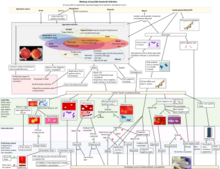

The CAMP test (Christie–Atkins–Munch-Peterson) is a test to identify group B β-hemolytic streptococci (Streptococcus agalactiae)[1][2] based on their formation of a substance, CAMP factor,[3] that enlarges the area of hemolysis formed by the β-hemolysin elaborated from Staphylococcus aureus.
- ^ Phillips EA, Tapsall JW, Smith DD (August 1980). "Rapid tube CAMP test for identification of Streptococcus agalactiae (Lancefield group B)". J. Clin. Microbiol. 12 (2): 135–7. doi:10.1128/jcm.12.2.135-137.1980. PMC 273541. PMID 7014603.
- ^ Wilkinson HW (July 1977). "CAMP-disk test for presumptive identification of group B streptococci". J. Clin. Microbiol. 6 (1): 42–5. doi:10.1128/jcm.6.1.42-45.1977. PMC 274694. PMID 328534.
- ^ "Laboratory Demonstrations". Archived from the original on September 28, 2008. Retrieved 2008-12-12.